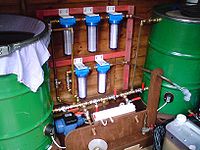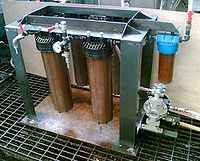Filtering waste vegetable oil
Preparation
Waste Vegetable Oil (WVO) contains different contaminants including food particles, water, Free Fatty Acids (FFAs) and animal fats. Many of these contaminants can be separated before the actual filtration stage in a settling tank. Oil is generally pre-treated in this way for about three weeks, though this settling process can be accelerated by pre-heating the oil to about 60°C. The animal fats, water and much of the food particle contamination will slowly sink to the bottom. The good oil can be extracted from the top of the tank and pumped into the filtration unit.
Note that filtration alone cannot remove Free Fatty Acids or other chemical or biological contaminants.
Filtration equipment
Home built filtration plants use cylindrical 5, 10 and/or 20 inch filter cartridges and/or bag filters, due to their low cost and easy availability. One or more are placed in series, with gradually reducing micron filtration grades. These are described as 50/20/5/1 or similar, denoting an initial 50 micron filter followed by a 20 or 10 micron all the way down to 1 micron. Such systems are usually driven by an electric pump such as the TAM105, or pneumatic pumping is employed.
Industrial systems use much larger filter cartridges and even bank many filters in parallel to improve throughput, using an air driven pump to push the oil through.
While filter housings can take high absolute pressures, usually 100psi (7 bar), the filter cartridges themselves typically shouldn't exceed 20 PSI (1.4bar) differential across any one filter. Care must be taken not to exceed the pressure rating for the cartridges used in the system or otherwise dirty oil will "blow-by" the seals on the cartridge.
Bag filters are also used. They are rated at 15psi (1bar) differential pressure across any one filter.
The waste oil can be heated to about 40°C for faster flow, but again, care should be taken as cartridges are even more prone to failure when hot.
The waste oil can be also be blended with a solvent to increase flow rate through the filters, as well as reducing settling time.

